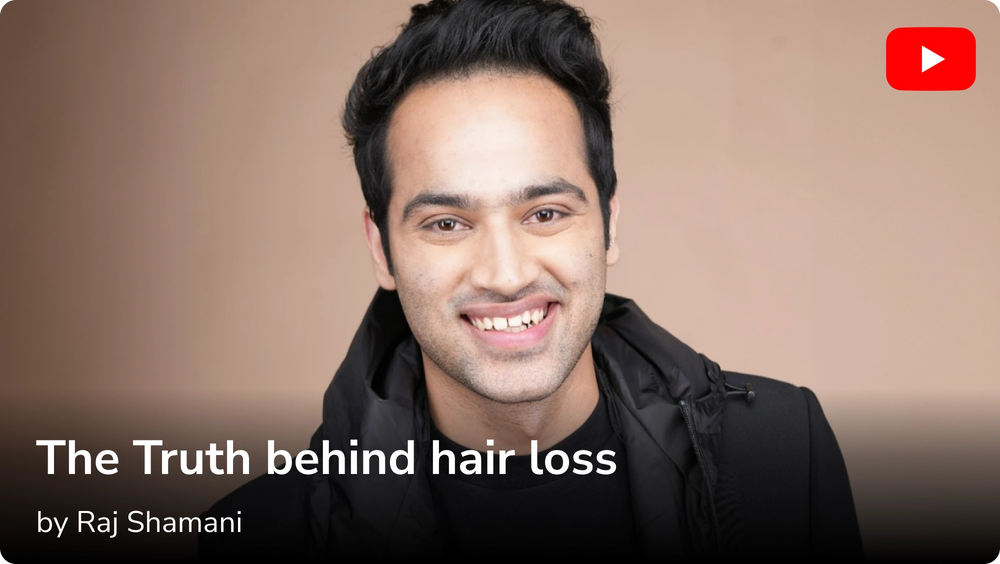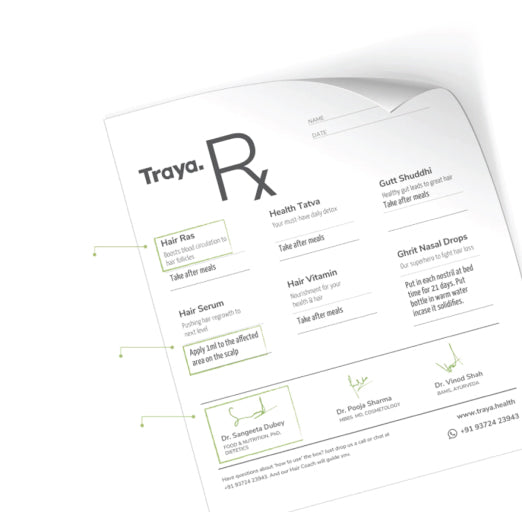Are you so tired of trying out products and remedies that all you want now is a QUICK FIX? We have seen over 8,00,000+ people at a stage where nothing seemed to work, and the hair fall only worsened. But little changes in your habits can take you very far, and we will tell you what they are!
The answer to “How to stop hair loss and regrow hair naturally” isn’t simple because well, regrowing hair in 3 weeks sounds ambitious. However, one can surely see a difference with the correct steps and consistency. It's all about knowing your hair and fulfilling its proper nourishment and growth needs.
You have probably already tried shampoo, oils, hair care routines and home remedies. Some might have worked a little, but nothing will completely solve your problem and regrow your hair. Do you know why? Because hair fall is personal. Everyone has different hair and a different lifestyle, so to know more about what kind of nourishment and treatment will be beneficial, it is essential to analyze the root cause of the problem.
Get to Know about the cause of your hair loss this hair test will help you with ways to address it directly. Root cause simply means the specific causes behind your hair fall. Stress, poor gut health, hormonal imbalances, dandruff, genetic factors, environment and lifestyle are a few root causes behind your hair being weak and falling. To find out what is causing your hair loss, all you have to do is look within and give Traya’s Free Online Hair Test.
Take Traya's Free Hair Test Today!!
Understanding Hair Growth & Hair Loss
Hair loss isn't just about genetics, it’s a sign of what’s happening inside your body. To truly regrow hair, we need to understand how hair grows, why it falls, and whether it can come back. Let’s break it down.
How does hair grow?
Hair grows in three phases:

- Anagen (growth phase): Lasts 2–7 years, determines hair length.
- Catagen (transition phase): Hair stops growing and detaches from the follicle.
- Telogen (resting phase): Old hair sheds, making way for new growth.
Why does hair thin or fall out?

- Genetics: Pattern baldness runs in families.
- Poor scalp health: Dandruff, oil buildup block follicles.
- Nutritional deficiencies: Lack of iron, biotin, or protein weakens hair.
- Stress & lifestyle: Hormonal changes, poor diet, and sleep deprivation impact hair health.
Can lost hair grow back?
If follicles are still active then Yes, regrowth is possible with the right treatment!
Want to know what’s causing your hair loss? Traya’s Hair Test analyzes your scalp and health to create a personalized regrowth plan just for you.
Fastest Ways to Boost Hair Regrowth in 3 Weeks
While hair regrowth takes time, certain remedies can stimulate faster results. Here’s how you can kickstart the process:
Ayurvedic Remedies for Hair Growth
Ayurveda has long relied on potent herbs to strengthen hair and promote regrowth. Try these proven remedies:

- Bhringraj Oil Massage: Boosts blood circulation and nourishes hair follicles.
- Amla : Packed with Vitamin C, it enhances collagen production for faster hair growth.
- Fenugreek (Methi) Hair Mask: Strengthens roots, prevents thinning, and accelerates regrowth.
Dermatology-Approved Treatments
For those looking for clinically backed solutions, these treatments help revive sluggish follicles:

- Microneedling (Derma Roller): Creates micro-injuries to boost collagen and enhance serum absorption.
- Caffeine & Redensyl Serums: Stimulate dormant follicles and improve hair density.
- Scalp Cleansing: Eliminates buildup, ensuring hair follicles absorb nutrients effectively.
Also Read: Dermatologist's Guide: How to use Derma Roller for Hair Growth
Nutrition for Hair Regrowth
What you eat plays a crucial role in hair health. Strengthen your strands from within with these essential nutrients:

- Protein: Supports keratin production—found in eggs, nuts, paneer, and lentils.
- Biotin (Vitamin B7): Promotes follicle growth—available in eggs, fish, nuts, and seeds.
- Vitamin B12 & Iron: Improve oxygen supply to follicles, preventing hair thinning. Get them from red meat, spinach, lentils, and eggs.
- Vitamin D & Zinc: Prevent excessive shedding and nourish follicles—sources include fatty fish, fortified foods, and nuts.
- Vitamin E & Magnesium: Combat oxidative stress and maintain healthy blood flow—found in spinach, avocados, almonds, and seeds.
- Calcium: Supports hormone balance for hair growth—available in dairy, tofu, broccoli, and beans.
Also Read: 20 Best Foods for Hair Growth
While these remedies may show visible improvement in three weeks, sustained hair regrowth requires a holistic, long-term approach. Traya’s doctor-backed treatment plan combines Ayurveda, dermatology, and nutrition to address hair loss at its root cause.
Take Traya's Free Hair Test Today!!
How to Regrow Hair Naturally in 3 weeks - Natural Remedies that Help
It is easy to know how to stop hair fall naturally and regrow hair naturally in 3 weeks and see substantial results by incorporating simple practices like taking care of your hair hygiene and oil frequently and having nutritious meals that ensure your deficiencies are addressed. Simple activities like exercising regularly and avoiding unhealthy food can go a long way. Moreover, stress management techniques and practising mindfulness also help.
Customer Testimonials:-

Scalp Massage:
Massaging your scalp regularly for about 15 minutes daily boosts the blood flow to your head. This nourishes your hair follicles and encourages healthy hair growth. So, if you want your hair to look and feel better, try adding a simple scalp massage to your daily routine. It's an easy way to care for your hair and make it healthier.
Essential Oils: Here are some oils that can promote hair growth.
Peppermint Oil:
Known for its invigorating properties, peppermint oil can promote hair growth. It stimulates blood circulation when mixed with carrier oil, such as coconut or jojoba oil, and applied to the scalp bi-weekly.
Also Read: How to use Derma Roller for Hair Growth
Black Seed Oil:
Black seed oil is recognised for its richness in nourishing compounds, including vitamins, minerals, and antioxidants. When used as a home remedies for hair growth and thickness, it supports healthy hair growth by providing essential nutrients to the hair follicles.
Marula Oil:
Marula oil is excellent for addressing scalp conditions and repairing damaged follicles. Rich in antioxidants and omega fatty acids, it moisturizes the scalp and helps maintain a healthy balance.
Also Read : Best Hair Growth Oils Recommended by Doctor
Aloe Vera Gel
Aloe vera has the potential to foster hair growth, particularly when the cause of hair loss is an inflammatory condition on the scalp. However, it is more probable that aloe vera contributes to overall hair health by providing essential conditioning and moisturization to both the hair and scalp. After cleansing the scalp and conditioning the hair with aloe vera, individuals may observe a reduction in hair breakage and loss. While some claim that aloe vera accelerates hair growth, there is limited clinical evidence to substantiate or refute such assertions. It's essential to recognize the beneficial impact of aloe vera in maintaining healthy hair, even though the extent of its influence on rapid hair growth remains inconclusive.
Coconut Milk
Naturally rich in fatty acids, coconut milk possesses exceptional moisturizing properties, leaving your hair soft and tangle-free. Packed with vitamins, proteins, zinc, and iron, coconut milk goes beyond surface benefits, working to maintain the overall health of your hair and scalp while promoting growth. Its nourishing qualities contribute to strengthened hair, growth stimulation, and combatting dandruff, making it an excellent choice for restoring dry hair.
Take Traya's Free Hair Test Today!!
Egg Mask
Using an egg hair mask is like giving your hair a boost of essential nutrients that help it grow longer. The biotin in egg yolks is great for improving hair elasticity, making your hair more flexible. The protein and biotin in eggs also support hair growth. Using an egg mask once or twice a month can help your hair regrow and become healthier and more elastic.
Curry Leaves
Can curry leaves regrow hair? The answer is yes. Curry leaves are packed with antioxidants, beta-carotene, and proteins that strengthen hair follicles, reduce thinning, and prevent premature graying. They also improve scalp health by combating dandruff and buildup. To use, you can boil curry leaves in coconut oil, strain, and massage it onto your scalp for deep nourishment. Alternatively, blend fresh curry leaves with yogurt to make a hair mask, leave it on for 30 minutes, and rinse. Including curry leaves in your diet also helps nourish hair from within.
Also Read: Redensyl vs Minoxidil - Which one is better?
Customer Testimonials:-

Traya’s Holistic Approach to Regrow Hair
Regrowing hair isn’t just about applying oils or serums—it’s about fixing the root cause of hair loss. That’s why Traya follows a scientific, inside-out approach to ensure long-lasting regrowth.
Our 3-pillar strategy combines Ayurveda, Dermatology, and Nutrition to address hair fall from every angle.

1. Ayurveda: Restoring Scalp Health Naturally
Did you know Ayurveda links hair loss to an imbalance in Pitta dosha? That’s why we use powerful herbs to calm the scalp, nourish follicles, and promote regrowth.
- Ayurvedic Herbs: Bhringraj, Amla, Brahmi, and Ashwagandha strengthen roots and improve scalp health.
- Traya’s Hair Oil & Supplements: Combat thinning and support stronger, healthier hair growth.
2. Dermatology: Stimulating Hair Follicles
While Ayurveda restores balance, modern dermatology helps reactivate dormant hair follicles and accelerate regrowth.
- FDA-approved Ingredients: We use Minoxidil alternatives like Redensyl & Procapil to restart the hair growth cycle.
- Scalp Cleanser & Hair Serums: A clean, buildup-free scalp absorbs nutrients better, leading to faster regrowth.
- Derma Roller & Scalp Massage: Boost blood circulation to hair follicles, delivering more oxygen and nutrients for healthier strands.
3. Nutrition: Strengthening Hair from Within
Hair needs the right nutrients to grow strong. If your body lacks key vitamins, even the best treatments won’t work as effectively.
- Traya’s Diet Plan: Packed with Omega-3s, protein, and antioxidants to nourish your hair from within.
- Personalized Supplements: We provide Biotin, Iron, and Vitamin D to support natural regrowth.
- Gut Health Correction: Poor digestion = poor nutrient absorption = weaker hair. We fix this so your body can fully utilize essential hair nutrients.
Still wondering what’s stopping your hair from growing? Take Traya’s Hair Test today! It identifies the root cause of your hair loss and provides a customized regrowth plan—so you can stop guessing and start seeing results.
Also Read: How to Use Traya Customised Hairfall Control Kit
What You Can Fix in 3 Weeks with Traya
Hair regrowth is a gradual process, but if you address the root cause correctly, you can see important changes in your hair and scalp health within three weeks.
|
Area |
What Improves in 3 Weeks |
|
Hair fall |
Daily shedding reduces by 30–50% |
|
Digestion |
Lighter stomach, better nutrient absorption |
|
Scalp Health |
Less dandruff, restored oil balance, reduced itchiness |
|
Sleep/Stress |
Improved calmness with Traya’s Calm tablets |
Week-by-Week Routine for Natural Hair Regrowth
Regrowing hair naturally requires patience and consistency, but with the right routine, you'll see visible results in just 3 weeks. Follow this step-by-step plan to kickstart your hair regrowth journey.
Traya’s 3-Week Kickstart Plan
The key to achieving visible changes in three weeks is a structured, plan backed by experts that focuses on both internal health and scalp treatment. Traya’s 3-week hair reset includes:
Step 1: Ayurvedic & Internal Health Correction
A strong digestive system is essential for hair growth because poor gut health leads to insufficient nutrient absorption. This leads to nutritional deficiencies ultimately triggering hair fall.
Traya Action:
-
Gut Shuddhi - a gut-healing tablet that helps improve digestion and boost nutrient uptake
-
Calm Ras - tablets to reduce stress-related hair fall
-
Personalized Ayurvedic supplements based on your hair test
Step 2: Scalp Care for a Healthy Environment
Your scalp needs the right balance of moisture and nutrients to support regrowth. A well-nourished and healthy scalp will create the perfect environment for strong and healthy hair.
Traya Action:
-
Anti-dandruff shampoo to maintain scalp hygiene, prevent buildup and reduce flaking.
-
Recap serum is a nutrient-rich serum that helps nourish follicles and strengthen hair roots
-
Scalp massage techniques to improve blood circulation. Regular scalp massages ensure better oxygen and nutrient supply to hair follicles facilitating hair growth.
Step 3: Minoxidil Application (if prescribed)
For those who are experiencing moderate to severe hair loss, Minoxidil is a clinically proven treatment that can help accelerate hair regrowth. It works by increasing blood flow to the hair follicles, prolonging the hair growth phase, and revitalizing thinning areas.
Traya Action:
-
1ml Minoxidil applied nightly for enhanced blood flow to follicles
-
Complementary scalp support through a soothing formulation that reduce irritation and flaking common side effects associated with Minoxidil.
-
Monitoring of progress and regular assessments to track progress and to adjust concentration if needed
Step 4: Diet & Lifestyle Adjustments
Food and routine play a crucial role in hair health. Hair health is a reflection of internal health. Diet and lifestyle are extremely important for hair health. A well balanced diet will ensure that hair gets all the nutrition it needs for growth. Similarly, a healthy lifestyle will help manage stress-related hair loss.
Traya Action:
-
Warm, home-cooked meals rich in protein, iron, and omega-3 fatty acids will help strengthen hair from within
-
Early dinner to support digestion and reduce inflammation. Eating atleast 2-3 hours before bedtime will aid in good digestion, increase nutrient absorption and reduce inflammation in the body.
-
Hydration and detox will support in flushing out of toxins.
-
Stress management - Including stress management practices like, meditation. Journaling or other mindfulness techniques will help lower stress levels, a common trigger for hair loss.
Step 5: Progress Tracking & Adjustments
Hair regrowth is a gradual process, and continuous tracking, expert guidance, and personalized adjustments are essential for long-term success. Every individual’s hair loss journey is different, and an adaptable approach ensures the best possible results.
Traya Action:
-
Weekly coach calls with hair coaches to assess progress, challenges, and hair health
-
Hair log on the Traya App, a dedicated app for progress tracking
-
Modifications and changes in treatment based on response and improvement in hair health.
No two customers are the same, similarly, the root cause of their hair loss would be different. Hence each step is customized based on the results of the hair test. This is not a one-size-fits-all routine. Your plan will be tailored to your hair loss type, scalp condition, and internal health.
Why Natural Doesn’t Mean Slow (When Done Right)
There is a common misconception that natural treatments take forever to show results. This isn’t true if the approach is scientific, personalized, and targeted. Hair fall treatment isn't just about topical medicines, it is about addressing the root cause and solving the problem from within.
Why Traya Works?
-
Backed by Ayurveda + Clinical Dermatology Traya combines ancient knowledge with modern science through a holistic approach that treats the root cause and not just the symptoms. While Ayurveda identifies internal imbalances like digestive issues, stress, and hormonal fluctuations, clinical dermatology focuses on hair follicle stimulation, scalp health, and targeted treatments.
-
Guided by doctors and real diagnostics – Traya’s process begins with a detailed hair test to understand the exact reason behind your hair loss. The plan is then curated by dermatologists, and Ayurvedic doctors, making it evidence-based and result oriented.
-
Designed for visible improvement in weeks – When followed with patience and consistency the right plan shows measurable changes in just 21 days.
The Science Behind Sustainable Results
-
Unlike temporary fixes Ayurvedic formulations target the root cause of hair loss (gut, stress, hormones)
-
Minoxidil & Redensyl stimulate follicles and improve density. These actives stimulate follicles, extend the growth phase (anagen), and improve overall hair density
-
Hair needs the right nutrients and environment for nourishment.Diet & lifestyle changes provide long-term support for new growth
-
Healthy scalp is key to hair growth.Scalp treatments prevent issues like dandruff, excess oil, or irritation
Treat the Root Cause, Not Just the Scalp!
Natural regrowth isn’t about applying a random oil or herbal remedy it works when you treat your root cause, not just your scalp.
Can You Switch Between Redensyl and Minoxidil?
Depending on your hair loss stage and scalp response, Traya doctors may adjust your treatment over time. Here’s how:
|
Scenario |
Recommendation |
|
Starting out, mild hair loss |
Redensyl can be a gentle starting point |
|
Stage 3 with visible patches |
Minoxidil is more effective |
|
Sensitive scalp with Minoxidil |
Traya may switch you to Redensyl temporarily |
|
Long-term plan |
Your doctor may rotate ingredients over time |
At Traya, your topical treatment is matched to your hair loss stage, ensuring long-term effectiveness.
Still Confused About Your 3-Week Hair Reset?
No need to self-diagnose!
Hair loss is complex, and the right treatment depends on factors unique to your scalp and body. That’s why Traya’s medical team is here to help.
Take the Hair Test and experts will analyze your hair loss pattern and prescribe the most effective solution for you.
Here’s What Three Weeks of Traya’s Hair Treatment Would Look Like
Week-by-Week Routine for Natural Hair Regrowth
Regrowing hair naturally requires patience and consistency, but with the right routine, you'll see visible results in just 3 weeks. Follow this step-by-step plan to kickstart your hair regrowth journey.
Week 1: Scalp Detox & Stimulation
The first step is to cleanse, nourish, and reactivate your follicles for healthy hair growth.
- Start Traya’s Hair Test to identify deficiencies and get a personalized plan.
- Apply Bhringraj & Amla oil to stimulate follicles.
- Use a mild, sulfate-free shampoo to remove buildup.
- Begin Biotin, Iron, and Omega-3 supplements to promote stronger hair.
- Perform derma rolling and scalp massage every alternate day to improve blood circulation.
Week 2: Strengthening & Nourishment
With your scalp prepped, it’s time to feed your hair the nutrients it needs to grow stronger.
- Continue Traya’s Scalp Treatment & Hair Growth Serum for deep nourishment.
- Add a protein-rich diet (eggs, lentils, nuts, and seeds) to support hair strength.
- Apply a Fenugreek or Yogurt hair mask weekly for conditioning and strength.
- Reduce stress with meditation, better sleep habits, and relaxation techniques—stress is a major cause of hair fall.
Week 3: Visible Signs of Hair Regrowth
By now, you should notice reduced hair fall and new baby hair growth. Keep up the routine for long-term results.
- Maintain your oil massage & scalp cleansing routine to keep follicles healthy.
- Avoid heat styling, harsh shampoos, and excessive washing to prevent damage.
- Stick to Traya’s Holistic Plan—consistent care ensures sustainable, long-term hair regrowth.
Also Read: Success stories and results from our customers
Take Traya's Free Hair Test Today!!
Conclusion
Regrowing hair naturally within a short timeframe requires Time and Consistency. By addressing underlying causes and nurturing hair follicles, incorporating practices like scalp massages, essential oils, and dietary supplements can lead to noticeable improvements in hair health and growth.
It is easy to find out the root cause of your hair fall and start working on it. Traya finds the root cause of your hair loss through a hair test and recommends a personalized kit made for YOU. In the first month, we directly address the root causes of your hair loss, which will start showing improvements in the first 3 weeks.
While expecting full regrowth within three weeks may vary for individuals, consistent application of these natural remedies offers a promising path toward revitalizing hair. For those wondering about the possibility of regrowing lost hair naturally, the key lies in a dedicated and multifaceted effort to support overall hair well-being.
- Embarking on a journey to regrow hair naturally is challenging but achievable with the right approach.
- Hair loss can result from genetic factors, hormonal imbalances, medical treatments, stress, and hairstyling practices. You can find out the cause by giving Traya’s free online hair test.
- Understanding the hair growth cycle, including the anagen, catagen, and telogen phases, is crucial in addressing hair loss.
- Natural remedies for regrowing hair in three weeks include scalp massages, essential oils like peppermint and black seed oil, marula oil, and onion juice.
- Dietary supplements containing Vitamin B12, calcium, magnesium, zinc, and iron can support hair health when dietary intake is insufficient.
People Also Ask (Frequency Asked Questions)
Q. Is it possible for hair to regrow within three weeks?
Yes, With the right treatment and nourishment according to your hair type it is possible to regrow hair in 3 weeks. For this to happen you must know the root cause of your problem and treat it in the way it's required. This may not be in the case of baldness but the sooner the problem is addressed better the results.
Q. How can I speed up hair growth effectively?
To boost hair growth effectively, maintain a nutrient-rich diet, indulge in regular scalp massages, and trim your hair regularly to prevent split ends. Use gentle hair care products, stay hydrated, and consider incorporating essential oils or supplements known for promoting healthy hair. Consistent practice of these habits can contribute to faster and healthier hair growth.
Q. What natural methods can accelerate hair growth in three weeks?
Promote faster hair growth naturally in three weeks by doing scalp massages, using essential oils like peppermint, maintaining a nutrient-rich diet, staying hydrated, and practicing gentle hair care. While individual results may vary, these methods can contribute to healthier hair within a short timeframe.
Q. Is natural regrowth possible for lost hair?
If your hair follicles are okay, it usually takes a few months to see real changes. But if your follicles are closed or the problem sticks around, it's best to see a hair specialist since natural methods might not do the trick. Massaging your scalp regularly and using certain products might help your hair grow naturally. Talking to a specialist is a good idea for personalized advice on how to deal with your hair concerns.
REFERENCES
-
Advances in hair growth
https://www.ncbi.nlm.nih.gov
-
Peppermint Oil Promotes Hair Growth without Toxic Signs
https://www.ncbi.nlm.nih.gov
-
Everything You Need to Know About Hair Loss
https://www.healthline.com




















